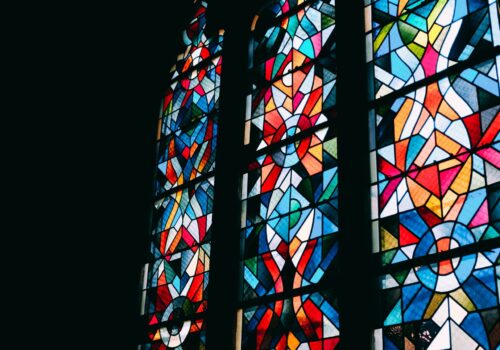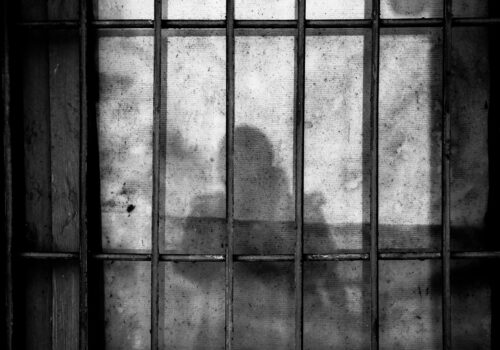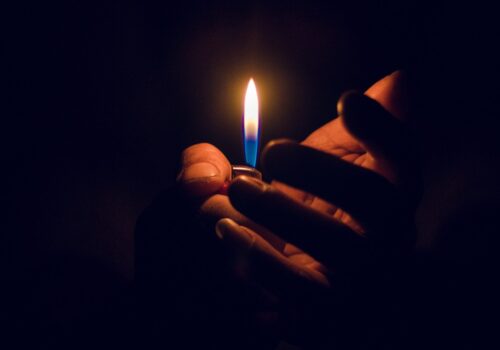Download PDF: Fischer, Orthodox Judaism Experience of the Divine
* Editors’ Note: This essay is part of the Roundtable on Ethnography and Religion.
Robert Orsi, in his opening essay, writes, “Jesus and the Blessed Mother, the angels and the saints are really present or really absent in this crisis; their action or their inaction have real consequences.” Reading that, I tried to think: is there anything like that in the religious tradition that I am part of and that as a social scientist I tend to investigate? Let me state at the outset what I think is the situation among Orthodox Jews, both on the basis of organized research and on the basis of sixty years of living among this community (or communities). On the level of spoken discourse, of conversation among social actors, you will almost never hear this sort of personalized reference to non-human figures, to an absence or presence of, say, God (with one possible exception). This claim, of course, strengthens all the academic and non-academic stereotypes regarding Orthodox Judaism—it’s about law (halacha, Torah), it’s about practice, it’s about community, but it’s not really about religion (i.e., God in the Christian sense). I am going to argue that this construction of Orthodoxy is not exactly true, but it is primary data that Orthodox Jews don’t talk the way Christians (both Protestants and Catholics) do.
Let me specify this a bit more. Orthodox Jews do talk about Providence, and some Orthodox Jews talk about Providence a lot. In some Orthodox circles (like where I live, in the ultra-Orthodox neighborhood of Har Nof in Jerusalem), you hear a lot of “Thank God,” “God Willing,” and “With the help of God.” Many Orthodox Jews seem to believe these phrases. For others, not an inconsiderable number, these God phrases have linguistic-communicative but not necessarily religious meaning. Thus, in many (most?) situations in which an Orthodox Jew (in Israel, at least) says “God willing” or “with the help of God,” you can assume that what is being talked about—a deal, a loan, a visit, a meeting—is not going to happen. “With the help of God” is a rider, a proviso, a way out of the commitment (i.e., God didn’t help, so the meeting did not take place). But even when such phrases are meant and taken seriously—there are many deeply religious people who use such phrases and mean them more or less literally—Providence is not exactly the same thing as the presence of Jesus or the Virgin Mary. Providence implies a relationship that is more removed— God worked his will and mysterious mechanisms so that I met my husband or succeeded in business.
Despite all this and despite the stereotypes, I suggest that there is an experienced holiness or a presence of holiness in the lives of Orthodox Jews, an experience of a Presence or something Other. However, this experience or this presence is not on the surface and it is the object of discussion only briefly and obliquely. It must be recovered or excavated and it involves many gaps and aporias. I am going to give three examples of this taken from my research or empirical observations. In each of these, I will excavate an experience of holiness or the divine and I will present some of the gaps surrounding it.
The first example is relatively trivial, but it goes to show that anthropological theory seems to help (surprisingly) in recovering the religious experience of Orthodox Jews. Israel is in the midst of some sort of religious revival. Without going into all the details, a certain small but important percentage of the non-observant Jewish population (the so-called secular population) in various ways is showing an interest in religious (for the most part Orthodox) text, worship, and observances. Various rabbinical groups are attempting to capitalize upon this by holding High Holiday services in classically non-observant locales such as kibbutzim and community centers in non-observant suburbs. The service—the prayers, recitations, and Torah readings—in each of these impromptu services is provided by young Orthodox men and women who are not yet married. This is especially prevalent on Yom Kippur (the Day of Atonement). Now, it turns out that these services are very popular with this young Orthodox population. This popularity should not be misunderstood. What attracts them is not the mere novel presence of the non-observant population. Most of these young people have had extensive experience and social relations with non-observant Israeli Jews whether in the army, the university, or at work. Furthermore, the population in many of these kibbutzim and suburbs are middle aged and elderly with some young families with children. It is also not the novelty of an impromptu service. For many of the participants, this year was the second, third, or fourth year of their participation. When I ask them what attracts them, what they say attracts them is “the quality of the service,” or “the quality of the prayers.” Some of them say that it is “special.”
I venture that what attracts them is the crossing of boundaries, which creates a sort of liminal anti-structure that provides a real experience of the holy. This creates the “special” quality of the service. I am alive to this possibility because I also personally strongly experienced this in regard to Yom Kippur services when my family and a number of other families organized High Holiday services at the Ministry of Health mental hospital adjacent to my haute bourgeois ultra-Orthodox neighborhood. We conducted the services together with the patients (that is, those who were not in closed wards or too drugged), who were encouraged to participate and given active roles. The result was a service of almost extreme liminality, which provided a felt communitas. I noticed the attraction of such a service, when my oldest son, off-duty from the Israel Defense Forces (IDF), elected to pray with us instead of going to his yeshiva (Talmudic academy) where the service could be expected to be especially intense and uplifting, saying that there was nothing like the service in the hospital. The liminality was only intensified by the fact that the hospital is located in the buildings of the former Palestinian village of Deir Yassin, site of an alleged 1948 war massacre.
Despite this, the legitimation for all of these impromptu services, whether in kibbutzim or in hospitals, is phrased in terms of acts of charity and loving kindness: to bring religion to the unfortunate non-observant or to extend charity to the unfortunates in hospitals, mental institutions, or prisons. Never is the special quality of the service in such places ever mentioned officially, and the liminal holy experience is almost never given voice, especially not officially. It is there diffidently and briefly, when people are asked or they try and explain to themselves and others why they participate.
One could object and say that liminality and the crossing of boundaries is fairly subversive, so, of course, it cannot have any official voice. My next example is taken from a context that is entirely and explicitly subversive, and, nevertheless, we see a similar gap.
For the past decade or so, I have been doing research on radical religious Zionism, that is, the religious-ideological movement that has led the settlement effort on the West Bank (and Gaza) for the past forty years. Originally, this research involved the study of aspects of radical religious Zionist ideology and theology. Recently, it has involved fieldwork and interviews with the most radical of settlers—the Hilltop settlers and youth (including those of the community of Hebron). Here, too, I find a gap between written theology and ideology and what is spoken about in conversation.
The most radical elements of this community have developed a theology of the religious authority of the radical activist in the service of the Redemption. That is, the engagé activist responding to the historical situation in (often violent) action, in fact, hears the general will of the Jewish nation and voice of God within him. The Call that the activist hears within him is, in fact, a lower rung of Prophecy which awards the activist religious authority which overrides the authority of established civic and rabbinic authorities.
This somewhat astonishing theology, which makes explicit reference to the work of Max Weber and through him to Nietzsche, represents a grafting of the European (Leninist and Fascist) theory of revolutionary avant-garde with the Romantic nationalist theology of R. A. I. Kook. It was, in fact, elaborated by an activist, Yehudah Etzion, from his prison cell in the early 1980s. Etzion was in prison along with other members of the Jewish Settlers Underground. The underground was responsible for the car bombings of three Palestinian mayors (who were severely maimed), the murder of three Palestinian students, and the wounding of a score of others in the attack upon the Islamic College in Hebron in 1982 (in revenge for terrorist killings of Jews in Hebron and other places). Etzion, specifically, was in prison for planning to blow up the Dome of the Rock on Temple Mount.
Though Etzion was an activist, he elaborated his theory of the renewal of prophecy and the revolutionary avant-garde as formal written (and brilliant) theology. This theory was taken up by other intellectual members of the most radical wing of radical religious Zionism, such as Motti Karpel and Moshe Faiglin. Karpel took it up in his ideological manifesto, The Revolution of the Faith, and Faiglin (who is really more of a political than intellectual figure) very recently, in his weekly column in the popular right wing, Orthodox- leaning newspaper, Makor Rishon, stated it very radically.1 He attacked established rabbinic authority as being inadequate for the historical moment on the cusp of Redemption and upheld the vision and authority of the charismatic activist.
But again, these are all written, general theoretical statements. How about the activists themselves—the kids, the Hilltop Youth in the illegal outposts, and the radical elements in the more established outposts (which have electricity and running water) in the hills of Samaria near Nablus (Shechem) and in Hebron? They are involved in endemic violence with the Palestinians (mutual attacks with knives, sticks, and rocks), sheep poisoning, and olive tree cutting. They are also involved in “Price Tag” retaliatory attacks against Israeli security forces’ property and personnel and desecration of mosques (and most recently a monastery) in retaliation for IDF evacuation of illegal outposts and settlements. Do they feel and do they talk about how they are moved by the Call and that they bear authority within themselves and in their engagement?
Here again, their talk about this seems to be very diffident and oblique. The kids and the activists are quite willing to talk about how the Israeli politicians and security forces are venal and hypocritical. They are also willing to talk about the conflict with the Palestinians, including invoking the biblical commandment “not to let any soul” of the Seven Nations of Canaan live (which they admit is not literally applicable). But they don’t seem to talk about the basis of their actions, and they especially do not talk about prophecy, answering God’s call, or anything like that. Their actions and their behavior, though, indicate their self-confidence. Thus, they have on occasion publicly flouted the rulings of rabbis (including “their” radical rabbis) in order to express or advance their radical nationalist agenda. On another occasion, an interviewer from Makor Rishon asked the very young residents (ages 17-24) of the tiny illegal outpost of Ramat Migron who they viewed as their rabbinic authority, a question that is very standard in Orthodox parlance. The girls dutifully answered Rabbi Lior (the very Anti-Arab and radical, but very erudite, rabbi of Hebron). The boys in the settlement did not answer. This non-standard behavior was not lost on the interviewer, who remarked upon it in her article. Rabbi Dov Lior, in fact, publicly proclaimed his admiration for the Hilltop Youth and has announced that the rabbinate and the Orthodox establishment should follow the radical youth’s initiative and their lead. Finally, under duress, activists will admit to an inner certainty, authority, and inspiration. Thus in his interrogation by the General Security Services after he assassinated Prime Minister Rabin, Yigal Amir denied that he was acting on the basis of a ruling given to him by any rabbi. Rather, he claimed that he was acting on the basis of his own inner certainty that this is what God wanted. (The interrogation protocols are still classified. I have spoken with people who have read the protocols.)
Thus again, in connection with political conflict and violence, there seems to be indications of a religious culture among the activists of inner inspiration and response to God’s call. Yet it is not a phenomenon which can be talked about given general Orthodox reticence about immediate, personalized experience of and contact with the divine.
The third example really relates to a wider problematic: religion and its context. In this section, I would like to talk about what is supposed to be the central religious activity of Orthodox Jews: Torah Study, which is said to be “the equivalent of all [the commandments].”2 All too often, in regard to the social scientific study of Judaism, Torah study gets taken over by its context, and I say this complaint in regard to my own work as much as anyone else’s work. An important study of yeshivot (talmudical academies) in Israel came out not long ago, Nurit Stadler’s Yeshiva Fundamentalism.3 The book treats of everything – the relationship to the army, masculine identity, sexuality and sin, and the world of work and family, but it does not devote systematic attention to that activity which supposedly occupies male yeshiva students between twelve to sixteen hours a day—Torah study. From an ethnographic perspective we know very little about Torah study in yeshivot. Does it, in fact, occur? To what extent? Is it concerned with Talmud (i.e., theory) or halacha (religious law or practice)? What is the relationship between theory and practice? What, if anything, does it mean to the students? Does it have a religious dimension? Or is it only cognitive and intellectual? Some of these questions relate to classic questions of Jewish philosophy and mysticism, but they have rarely been asked in a contemporary ethnographic context.
The closest thing we have, in my opinion, to a study of Torah study in context, in which Torah study is not collapsed into context, are the fabulous studies of twelfth century Tosafists conducted by Haym Soloveitchik.4 Soloveitchik documents the intellectual and religious revolution led by RaSHY (R. Shlomo Yitzchaki, d. 1106, Troyes, Champagne) and his descendents and its social and economic implications and consequences, not the least of which included the relations with the surrounding Christian society. Reading Soloveitchik, one gets a sense of the changes in Talmudic methodology and the rules of Talmudic discourse that the Tosafists initiated and led and, at the same time, the interplay of halachic rulings with religious, social, and economic factors.
One question that arises with the issue of the meaning of Torah Study is the relationship of Torah study to religious experience and specifically to the Presence of the divine (a question that has arisen in various contexts in Kabbalah and Hasidism). Prominent testimony in this regard was provided in the twentieth century by Rabbi J. B. Soloveitchik (Haym Soloveitchik’s father), the foremost Talmudist since WWII:
There are times when I study Torah late at night and the night is suited to Torah study. The Torah studied at night is clearer and sharper and at times I feel during study that someone is standing over me, leaning over my shoulder and looking at the Talmud page and the issue that I am occupied with at that moment and nods his head at a new idea [sevarah] [that I had] and am still trying to decide whether it is correct or not. If I had been able to endure what has come over me these past three years, [since his wife, Dr. Tonya Soloveitchik passed away] it is only because for me “Torah from Heaven” is not something which I merely “believe” but rather which I “know” [is present for me with existential certainty.]5
This passage, while utterly personal, appears in the context of a lecture on the theology and phenomenology of repentance and was taken from the approved written transcription of that lecture. (I know from personal experience that Soloveitchik had the ability to be utterly personal when addressing 3000 people.) In other words, this passage appears as written. Do we again have here a phenomenon of something that can be written but can’t be spoken? Does Torah study appear as religious experience, as presence of the Divine in the everyday experience and conversation of ordinary Jews in yeshivot, in the synagogue and havurahlearning groups in Israel and spread across the United States?
One place to start looking would be in the learning experiences of the non-intellectual strata. In a recent study of increased religionization among IDF non-commissioned officers (radio and communications specialists, motor pool, food service and cooks, supply and logistics personnel) conducted by Chen Bram and myself, the importance of Torah study assumed major proportions. Many NCOs spoke enthusiastically of participation in synagogue study groups at night after work (on the base or off it). As we demonstrated, such study groups provided the NCOs with human fulfillment (engagement in value-laden deliberation and discussion, the modern equivalents of philosophy and politics for the ancients) and multicultural recognition that directly compensated for their low position in the professional and status hierarchy of the military.6
In addition, in a study done around 1980 on newly religious Orthodox Jews in which I served as research assistant, new religious Jews from low socioeconomic strata enthusiastically spoke about Torah study in connection with curing addiction and substance abuse.7 Thus, the question arises: what is the experience of Torah study for those of non-intellectual and low SE strata along with that of elites? Does it involve for anyone non-mediated contact with the Divine?
I will close this short essay by referring to the one exception to the rule of not talking about unmediated religious experience—the yearly pilgrimage on Rosh Hashana to Uman, Ukraine, to the grave of R. Nachman of Bratslav. What was once the most marginalized of events—restricted to a small group of ostracized Bratslaver Hasidim—has become a major event in which tens of thousands from all walks of life participate. I have been repeatedly told by participants that direct contact with God (talking to God, being heard by God, etc.) is at the center of this experience and constantly talked about by everyone. Does this presage a change in Orthodox religious culture?
So does doing fieldwork and ethnography challenge our conceptions? Probably yes. Does it do so enough? Probably not. So we are in need of improvement (tikkun).
Notes
- Mishneh Peah 1.1
- Mishneh Peah 1.1
- Nurit Stadler,Yeshiva Fundamentalism: Piety, Gender, and Resistance in the Ultra-Orthodox World (New York: New York University Press, 2009).
- Priniciples and Pressures: Jewish Trade in Gentile Wine in the Middle Ages, Tel Aviv, Alma/Am Oved, 2003. (Hebrew.);Wine in the Middle Ages – Gentile (Idalatrous) Wine: A Chapter in the History of the Halacha in Medieval Germany. Jerusalem, The Zalman Shazar Center for Jewish History, 2008. (Hebrew).
- J. B. Soloveitchik,On Repentance: Lectures (Press Name: Jerusalem, 1976), 208-9. This is my translation from the Hebrew transcription of a lecture given in Yiddish in 1971.
- Chen Bram and Shlomo Fischer, “Religion as a Resource for Recognition and Freedom: Work, Class and Religion among Non-Commissioned Officers in the IDF in Shlomo Fischer and Nissim Leon (eds.)Religion and Class in Israel. Tel Aviv: HaKibbutz Hameuchad and Van Leer Jerusalem Insititute, Forthcoming.
- Janet Aviad,Return to Judaism: Religious Renewal in Israel (Chicago: University of Chicago Press, 1982).






